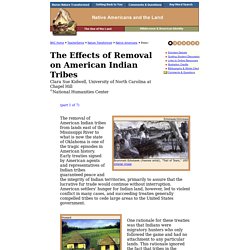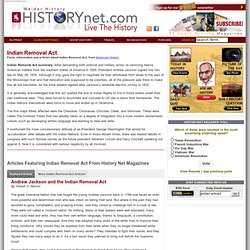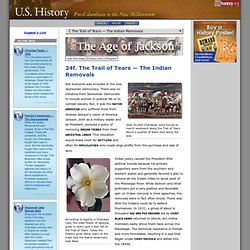

President James Polk: Mexican–American War Speech - 1846 - Hear and Read the Text. Mexican American War - 1of6. Lewis & Clark’s Expedition to the Complex West. This activity can be used as an introduction or for a closer study of the Lewis & Clark Expedition.

Trail of Tears National Historic Trail. America's Great Indian Nations - Full Documentary. The Effects of Removal on American Indian Tribes, Native Americans and the Land, Nature Transformed, TeacherServe, National Humanities Center. (part 1 of 7)The removal of American Indian tribes from lands east of the Mississippi River to what is now the state of Oklahoma is one of the tragic episodes in American history.

Early treaties signed by American agents and representatives of Indian tribes guaranteed peace and the integrity of Indian territories, primarily to assure that the lucrative fur trade would continue without interruption. American settlers' hunger for Indian land, however, led to violent conflict in many cases, and succeeding treaties generally compelled tribes to cede large areas to the United States government. One rationale for these treaties was that Indians were migratory hunters who only followed the game and had no attachment to any particular lands. Indian Removal Act. By Robert V.

Remini The great Cherokee Nation that had fought the young Andrew Jackson back in 1788 now faced an even more powerful and determined man who was intent on taking their land. But where in the past they had resorted to guns, tomahawks, and scalping knives, now they chose to challenge him in a court of law. They were not called a ‘civilized nation’ for nothing. Many of their leaders were well educated; many more could read and write; they had their own written language, thanks to Sequoyah, a constitution, schools, and their own newspaper. Prior to that action, they sent a delegation to Washington to plead their cause. President Andrew Jackson's Message to Congress 'On Indian Removal' (1830) War of 1812 (Katy Perry "Roar" Parody) - @MrBettsClass. Monroe Doctrine. Two things had been uppermost in the minds of Adams and Monroe.

In 1821 the Russian czar had proclaimed that all the area north of the fifty-first parallel and extending one hundred miles into the Pacific would be off-limits to non-Russians. Adams had refused to accept this claim, and he told the Russian minister that the United States would defend the principle that the ‘American continents are no longer subjects of any new European colonial establishments.’ More worrisome, however, was the situation in Central and South America. Revolutions against Spanish rule had been under way for some time, but it seemed possible that Spain and France might seek to reassert European rule in those regions. Indian removal. The Trail of Tears — The Indian Removals. Over 20,000 Cherokees were forced to march westward along the Trail of Tears.

About a quarter of them died along the way. Not everyone was included in the new Jacksonian Democracy. There was no initiative from Jacksonian Democrats to include women in political life or to combat slavery. But, it was the Native American who suffered most from Andrew Jackson's vision of America. Jackson, both as a military leader and as President, pursued a policy of removing Indian tribes from their ancestral lands. The U.S.-Mexican War . For Educators . Manifest Destiny. Grade Level(s): Subject Area(s) Language Arts - Reading and Writing, Civics, Geography, U.S.

History Estimated Time One to two 45-50 minute class periods. The Mexican-American War: Arguments for and against Going to War. The U.S.-Mexican War . Interactive Timeline. HISTORY TALKS: James Madison, Father of the Constitution. CHRONOLOGICAL TABLE of the PRINCIPAL EVENTS in America From 1776 to 1876. September 7.

—General Lafayette embarked for France in the United States frigate Brandywine. July 4. —John Adams, aged 91, of Massachusetts, and Thomas Jefferson, aged 83, of Virginia, both died on the fiftieth anniversary of the independence of their native country. September 13. —William Morgan, who had published a pamphlet divulging the secrets of Masonry, was abducted from Canandaigua, N. Heavy forces were sent against the Winnebago Indians, who had become troublesome They were overawed and gave up a number of murderers in their tribe. November 14. February I1. January 19.
Introduction to the Antifederalists. Who were the Antifederalists and what did they stand for?

Why the name Antifederalist? The name, Antifederalists, captures both an attachment to certain political principles as well as standing in favor and against trends that were appearing in late 18th century America. It will help in our understanding of who the Antifederalists were to know that in 1787, the word “federal” had two meanings. One was universal, or based in principle, and the other was particular and specific to the American situation. The first meaning of “federal” stood for a set of governmental principles that was understood over the centuries to be in opposition to national or consolidated principles.
Revolutionary War Timeline. Learning Resources - Info Sheets, Handouts, Bibliographies - The Monticello Classroom. (1) America, the Story of US - Rebels. Westward - American History in HD - Documentary. Www.socialstudies.com/pdf/ZP391sample_SlaveryTG.pdf.
We the People: The Citizen & the Constitution, Level 3.